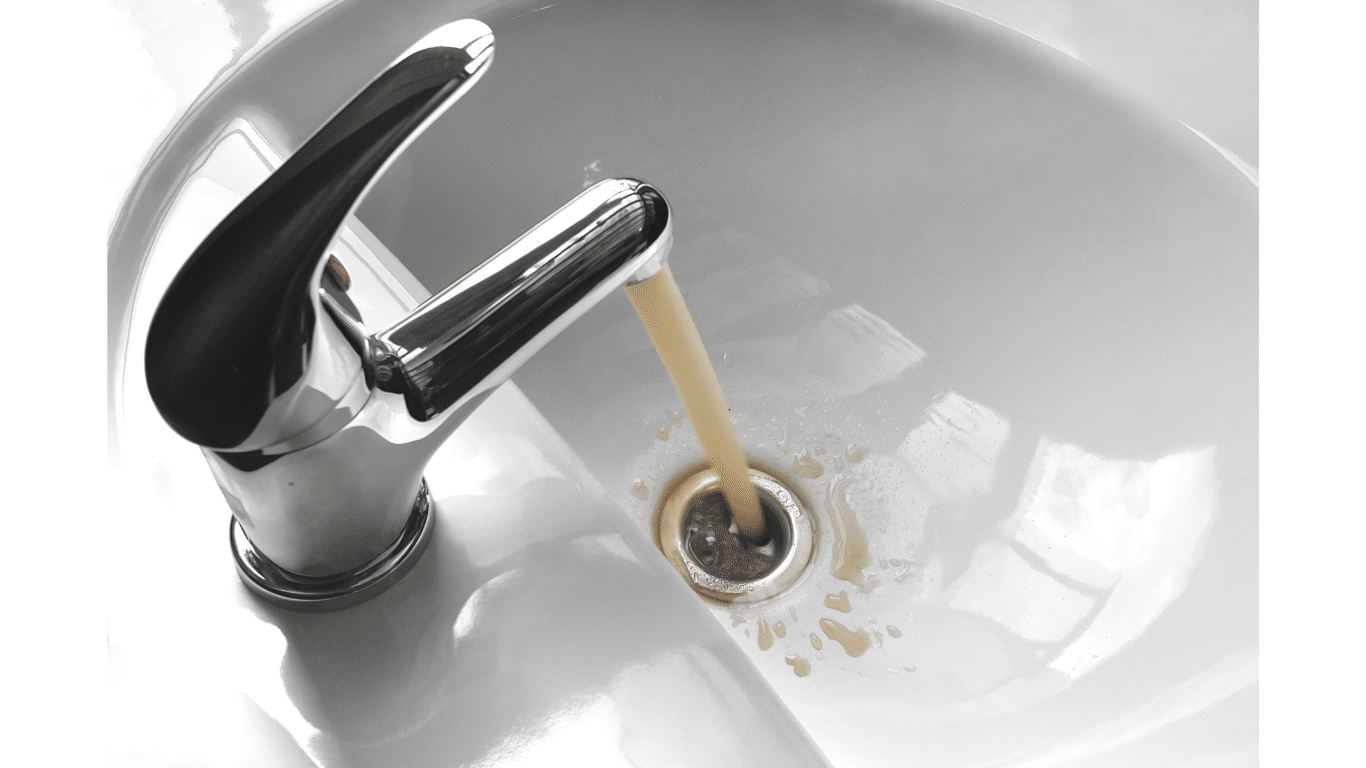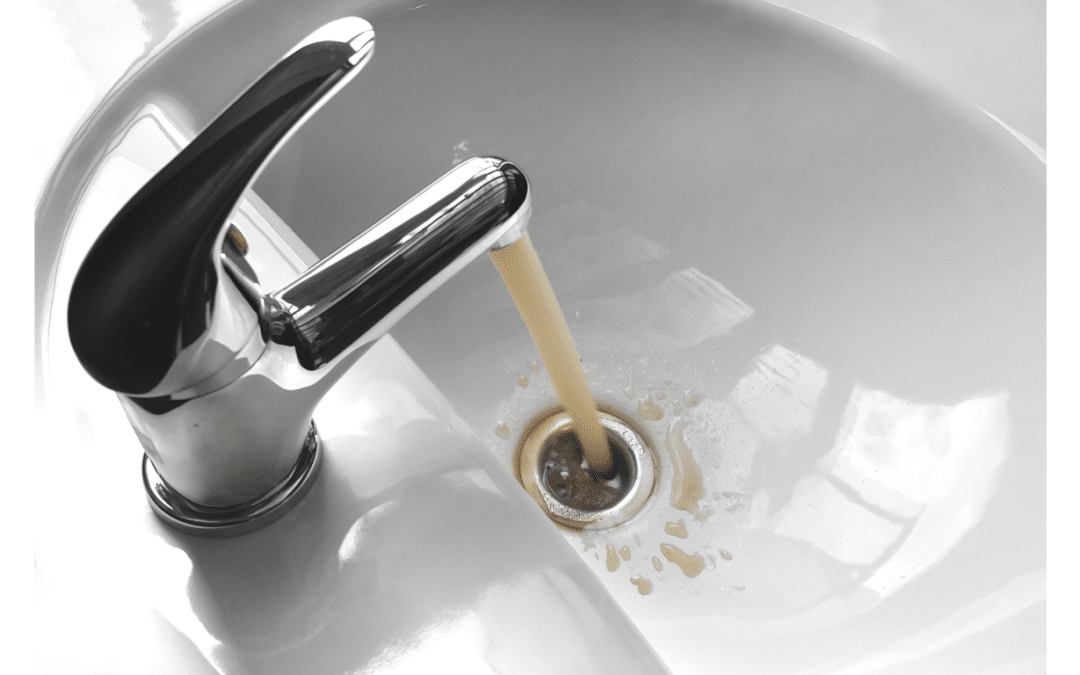Do you find yourself troubled by reddish-brown stains in your sinks, toilets, and laundry and have a nagging suspicion it could be due to iron present in your well water?
Are you worn out with the metallic taste that spoils your morning coffee and wonder if too much iron is to blame?
Are you pestered with yellow well water but unsure why this is happening?
Well, you’re not alone!
Iron is one of the most abundant elements in the Earth’s crust, and it naturally finds its way into our water supply. It can take two forms – ferrous iron, soluble and dissolved iron, and ferric iron, an oxidized form. When exposed to air or other oxidants, ferrous iron can turn into ferric iron, giving your water an unappetizing yellowish tinge.
Navigating the world of water treatment might seem daunting with the swirl of jargon like ‘ferrous or ferric iron,’ ‘resin bed,’ ‘air injection,’ and ‘bacterial iron.’
But do not worry!
Whether you’ve got clear water iron, bacterial iron, or both lurking in your water, we’ll show you how to banish them and safeguard your drinking water.
Excess iron is more than just a nuisance; it’s a vampire that sucks the life out of your plumbing fixtures and can even reduce household water pressure. But with the proper knowledge and tools, you can remove iron from your well and restore peace to your home.
Stick with us, and by the end of this article, you’ll have a roadmap for dealing with that pesky iron, no matter how much iron is hiding in your water.

How Does Iron Get Into Well Water?
Iron in your well water might feel like an unwelcome houseguest, but understanding how it gets there in the first place can be the first step to showing it the door.
The Natural Occurrence of Iron
-
Iron and the Earth’s Crust: Iron is the fourth most common element in the Earth’s crust, meaning it’s practically everywhere. Over time, the process of weathering breaks down rocks, releasing iron particles into the soil. This iron-rich soil is the first stop on our journey.
- Groundwater and Iron: As water travels through this iron-bearing soil, it picks up soluble iron along the way, like a hitchhiker catching a ride. This groundwater eventually seeps into our wells, bringing the iron along with it. So, when you notice ferric or ferrous iron in your water, it’s just a part of nature doing its thing.
Human Activities Amplifying Iron Levels
-
Mining and Industrial Waste: It’s not just nature to blame. Human activities, like mining, can increase the amount of iron in our water supply. When waste from these activities isn’t correctly managed, it can leach into groundwater, boosting those iron concentrations.
- Iron Pipes and Water Systems: Lastly, the systems we use to transport our water can contribute to the problem. Older water systems often use iron pipes, which can rust and leak iron into the water. Over time, this leads to iron-contaminated water flowing from your taps, making removing iron from well water a necessity rather than a choice.
How Does Iron in Water Damage Your Home?
Now that you understand how iron sneaks into your water, let’s discuss the trouble it can cause. The impacts of high iron concentrations in your water supply are far-reaching, touching everything from the taste of your morning brew to the life of your appliances.
Aesthetic and Cosmetic Consequences
-
The Yellow Water Dilemma: Got yellow water? It’s likely due to oxidized iron particles, which can give your water a displeasing yellowish tinge. This unappetizing color indicates that iron is gate-crashing your water supply.
- Unpleasant Taste and Smell: If your water tastes like you’re sucking on a rusty nail, it’s probably due to the iron present in it. Ferric iron can also give your water a metallic smell, turning your refreshing glass into an olfactory ordeal.
Negative Impacts on Plumbing and Appliances
-
Clogging Pipes: Iron minerals in your water can build up inside your pipes, creating a scale that restricts water flow, reducing water pressure, and causing pipe clogging. This can make your shower feel more like a drizzle than a downpour, leading to costly plumbing repairs.
- Stains and Spots: Ever noticed reddish-brown stains in your toilet bowl or toilet tank? How about on your laundry or appliances? That’s the handiwork of iron. These stains are stubborn and tough to clean, meaning more elbow grease and potential damage to your fixtures and fabrics.
The damage caused by iron in well water can significantly hurt the neck (and wallet!). But don’t worry, iron is a problem that can be tackled. Removing iron from your well water isn’t just about improving aesthetics—it’s about safeguarding your home.
5 Ways to Remove Iron from Well Water
You’ve recognized the iron invader, noted its harmful effects, and now it’s time to strike back! Here are five proven methods to banish iron from your well water and reclaim the crisp, clear water your home deserves.
A. Mechanical Filtration
Mechanical filtration, including sediment and iron filters, is the front line of defense against iron. These systems filter out the larger iron particles from your water, transforming it from an iron-rich soup to refreshing drinking water.
-
Pros: Mechanical filtration is a straightforward, cost-effective solution for iron removal. It’s great for lower concentrations of iron and requires minimal maintenance. Plus, who doesn’t love the satisfying sight of clear water?
- Cons: However, mechanical filtration is less effective for removing ferrous iron or dissolved iron particles. Plus, it might struggle to cope with high concentrations of iron.
B. Ion Exchange
The ion exchange process, a water softener, is a popular method for removing iron from well water. Water softeners replace iron and other minerals with sodium ions, rendering the iron harmless.
-
Pros: Ion exchange is an effective ferrous and ferric iron solution. It can handle higher iron content and improve the taste and softness of your water. Plus, resin beads in the softener can extend the life of your plumbing fixtures.
- Cons: Iron bacteria can gum up the resin bed over time, requiring more frequent maintenance. Also, the added sodium can be a downside if you’re on a low-sodium diet.
C. Oxidation Filters
Oxidation filters, including air injection iron filters and manganese greensand filters, turn soluble iron into insoluble particles that can be filtered out. Oxidation filters effectively remove iron, especially when combined with other filtration systems.
-
Pros: Oxidation filters can handle ferric, ferrous iron, and hydrogen sulfide. These systems are efficient and often come as chemical-free iron filters.
- Cons: They require a certain amount of dissolved oxygen in the water to work effectively. Also, they might struggle with very high concentrations of iron.
D. Chemical Feed Pump with Chlorine Injection
A chemical feed pump introduces a disinfecting agent (like chlorine) into your water supply, oxidizing the iron and making it easier to filter out.
-
Pros: These systems are very effective against high iron concentrations and can treat iron bacteria.
- Cons: The downside is they require more maintenance, and the water may require post-treatment to remove the taste and smell of chlorine.
E. Reverse Osmosis
Reverse osmosis forces water through a semipermeable membrane, leaving impurities (like iron) behind.
-
Pros: These systems can effectively remove iron and many other contaminants. They also improve the taste of your water.
-
Cons: They require a fair bit of maintenance and can be more expensive to install and run. They also waste some water in the process.
As you can see, there’s more than one way to banish iron from your water. Each method has strengths and weaknesses, so consider testing your water to determine the iron content and choose the most suitable solution for your home.
Final Thoughts
Ready to reclaim your drinking water from the grip of iron?
Whether it’s bacterial iron, ferric, or ferrous, iron has no place in your home’s water supply. With multiple iron removal systems at our disposal, including water softeners, sediment filters, air injection iron filters, and iron water filters, we at WildHeron Drilling are experts at restoring your water to its pure, iron-free state.
Not sure about your iron content or what treatment process will suit your needs?
No problem! We offer water testing and will tailor a solution specifically for your home. Say goodbye to iron stains in your toilet tanks and hello to clear, refreshing water.
Remember, we’re more than just a drilling company. We’re your partner in achieving the healthiest water possible. Don’t let iron hijack your water any longer.
Reach out to WildHeron Drilling today for a quote.

